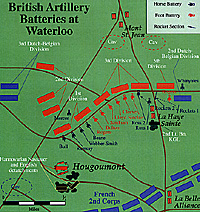Beane's Troop D (five 9-pdrs and one 5.5" howitzer). Major Beane was killed early in the battle. His troop took part in the repulse of the French Middle Guard.
Bull's Troop I (six 5.5" howitzers) is credited with firing the first Allied shot of the Battle of Waterloo which reputedly killed three members of the 1st Legere Regiment. It demonstrated considerable skill in placing fire near the Hougoumont complex and into the adpining orchards, causing considerable havoc among Prince Jerome's attacking French troops. Major Bull was wounded at the battle.
Gardiner's Troop E (five 6-pdrs and one 5.5" howitzer) supported Vivian's British cavalry brigade on the Anglo-Allied left (off map) and took an active role in pursuing and breaking the last French resistance that evening.
Mercer's Troop G (five 9-pdrs and one 5.5" howitzer) was initially deployed on the Anglo-Allied right in reserve. Committed by Sir Augustus Frazer to support two "unsteady" Brunswick infantry squares, Mercer's disregard of Wellington's standing order - to retire into the squares when charged by enemy cavalry - may have saved Wellington's right flank from a serious crisis during the massive French cavalry attacks. Mercer's men stood to their guns, suffering heavy losses mainly from dismounted cavalry skirmishers, but repulsed three separate attacks by French cuirassiers (and others) with devastating salvoes of canister.
Ramsay's Troop H (five 9-pdrs and one 5.5" howitzer). Major Ramsay, immortalized for saving his guns at Fuentes de Onoro, was killed at the height of the action during the French cavalry attacks. According to his replacement Captain Sandilands, the battery took part in the repulse of the French Middle Guard.
Ross's Troop A (five 9-pdrs and one 5.5" howitzer), nicknamed the "Chestnut Troop", deployed just to the rear of La Haye Sainte and fell back to the right after the French took the farm late in the day under Marshal Ney's direction. Three of Ross's guns were disabled by fire from the French grand- battery.
Webber-Smith's Troop F (five 6-pdrs and one 5.5" howitzer) initially came into action to the right of Hougoumont but withdrew as the French attack became subsumed by the trees around Hougoumont. It suffered heavily from French counter-battery fire while deployed in that role. Then it took up positions to the left of Bull and Ramsay where it helped repulse the famous French cavalry attacks. Webber-Smith claimed to have fired his last ammunition at the assault of the French Middle Guard.
Whinyates's 2nd Rocket Troop (five 6- pdrs and one section of rockets) supported Ponsonby's celebrated cavalry charge against d'Erlon's 1st Corps, after which French lancers counter-attacked and killed Ponsonby and many in his command. Whinyates's battery supported Kempt's British brigade the remainder of the day. Depending on the source, anywhere from 52 to 300 rockets were fired at the Battle of Waterloo by Whinyates's battery. According to Bowden's Armies at Waterloo, Whinyates's 6-pdrs fired a total of 309 round shot, 236 spherical case ("Shrapnel"), and 15 canister rounds (an average of 112 rounds per gun). Whinyates was wounded at the battle.
At Waterloo, there were 1781 British foot artillerists with 30 guns (five Royal Artillery batteries) and 1212 horse artillerists with 47 guns (eight Royal Horse Artillery batteries). Including Dutch, Brunswickers, and King's German Legion horse batteries, Wellington had more horse artillery at Waterloo than foot artillery: 85 horse compared to 72 foot guns.

More British Royal Horse Artillery
-
Introduction
Early Organization and Evolution
Battlefield Innovations and Advantages
At Waterloo, 1815
Organization at Waterloo
Large Map of Artillery Positions at Waterloo (slow: 180K)
RHA Uniform Plates: 1793 and 1815 (slow: 144K)
RHA Uniform Plates: Mercer Troop G at Waterloo (73K)
Cover Illustration: RHA at Fuentes de Onoro, 1811 (slow: 211K)
Back to Table of Contents -- Napoleon #12
Back to Napoleon List of Issues
Back to MagWeb Master Magazine List
© Copyright 1998 by Emperor's Press.
This article appears in MagWeb (Magazine Web) on the Internet World Wide Web.
The full text and graphics from other military history magazines and gaming magazines are available at http://www.magweb.com